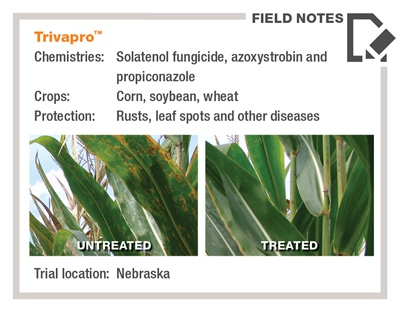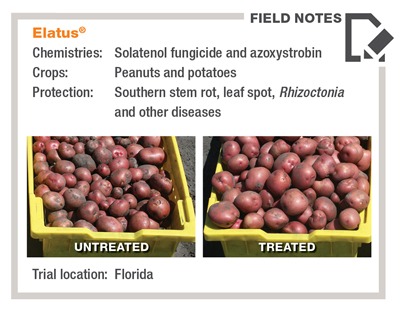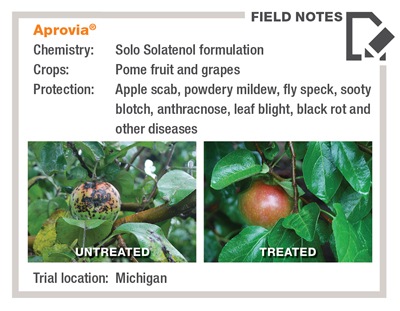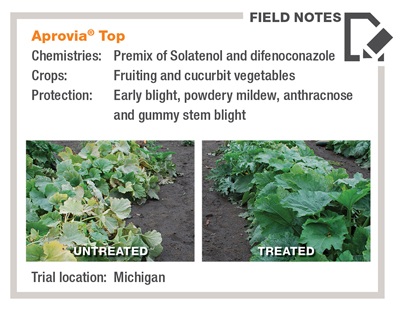IMAGES COURTESY Syngenta
Throughout history, innovators have challenged the status quo. Alexander Graham Bell didn’t settle for a telegram, Thomas Edison envisioned a better light source, and the Wright brothers refused to stay on the ground. The same can be said of Syngenta plant pathologists. They realize good tools to control disease currently exist, but their aspiration to create something better is resulting in a pipeline filled with promising new fungicides.
Standout Solution
One of the technologies generating the most excitement is Solatenol fungicide. Its roots date back to the Asian soybean rust epidemic in Brazil earlier this century. Faced with a pathogen that had caused an estimated $20 billion in damage, Syngenta researchers set out to develop a breakthrough that would help alleviate a problem existing tools could no longer control. After years of research, Solatenol emerged as the standout foliar SDHI (succinate dehydrogenase inhibitor) fungicide, which protects the outer layer of the leaf as well as the inner tissue.
“We developed a molecule that is intrinsically highly active on this disease at low rates and with long-lasting effect,” says Eric Guicherit, technical lead for arable fungicides at Syngenta. “In our trials, Solatenol-treated soybeans yielded 240 to 480 kilograms per hectare (4 to 8 bushels per acre) above the best market standard.”
While the Asian soybean rust epidemic inspired the creation of Solatenol fungicide, the applications for this potent active ingredient expanded well beyond South American soybean fields. Syngenta researchers quickly discovered multiple uses across more than 10 crops in the U.S.
“Even though we don’t have the widespread epidemic that Brazil had, we think U.S. growers should have access to this proven technology,” says Allison Tally, Ph.D., technical fungicide lead at Syngenta. “Our research shows that Solatenol fungicide has outstanding intrinsic activity on many diseases, including rusts, leaf spots, Southern stem rot and apple scab.”
As a result, Syngenta has created four Solatenol-based products specifically formulated for the specialty, vegetable and row crop markets. The products are currently pending approval by the U.S. Environmental Protection Agency (EPA).
Potent Performance
The lineup of upcoming Solatenol-containing formulations includes Trivapro, Elatus, Aprovia and Aprovia Top. Upon registration from the EPA, each will provide excellent preventive disease control, reliable crop safety, long-lasting residual control, tank-mix flexibility and a chemistry that is 10 times more effective than other SDHI fungicides. Each formulation will also bring unique rewards to its respective market:
- Trivapro: Harder Working, Longer Lasting
Developed for corn, soybean and wheat growers, Trivapro will be the first fungicide to contain three modes of action  with availability in all three crops. A combination of Solatenol fungicide, azoxystrobin and propiconazole, Trivapro has outperformed current market offerings and demonstrated excellent activity on rusts, leaf spots and other key diseases in preregistration trials.
with availability in all three crops. A combination of Solatenol fungicide, azoxystrobin and propiconazole, Trivapro has outperformed current market offerings and demonstrated excellent activity on rusts, leaf spots and other key diseases in preregistration trials.
“Trivapro performed better than anything else in our wheat trials, even under very intense stripe rust and leaf spot pressure,” says Peter Bruno, president of Agricumbia Resources Company in Richmond, Texas. “The level of disease control is phenomenal. In my 30 years in the business, this is one of the few products that really excites me. It’s a compound you’ll remember for the rest of your life.”
The preventive and curative activity of Trivapro also is evident in corn research trials. “In our plots in Kansas, Trivapro was applied at green silk and controlled Southern rust throughout the grain-fill period,” says Spencer McIntosh, agronomy service representative for Syngenta. “It really stood out compared to the other treatments.”
A primary source of Trivapro’s strength comes from its multiple modes of action. “When you have three different modes of action that are all unique, a fungus must overcome three different mechanisms to become resistant,” says Eric Tedford, Ph.D., technical fungicide lead at Syngenta. “This makes the process of developing resistance much more difficult.”
Beyond disease control and resistance management, growers can expect Trivapro to deliver crop-enhancement benefits as well. While these benefits may be harder to see during the growing season, the effects become evident at harvest. Trivapro-treated crops have stronger stalks and pods, enabling them to dry down in fields longer. Trivapro also helps reduce lodging and shattering, which ultimately decreases volunteer crops, improves harvestability and increases profit potential.
Keeping the intense disease spray regimens of peanuts and potatoes in mind, Syngenta developed Elatus, a formulation of Solatenol fungicide and azoxystrobin.
 Upon registration, Elatus will control Southern stem rot white mold (commonly known as white mold in the Southeast), leaf spot and other costly diseases in peanuts. “In our Elatus trials, we saw a product that managed disease and resistance,” says Bob Kemerait, Ph.D., University of Georgia Extension specialist. “It will be an important tool for resistance management.”
Upon registration, Elatus will control Southern stem rot white mold (commonly known as white mold in the Southeast), leaf spot and other costly diseases in peanuts. “In our Elatus trials, we saw a product that managed disease and resistance,” says Bob Kemerait, Ph.D., University of Georgia Extension specialist. “It will be an important tool for resistance management.”
Elatus also will offer tank-mix and application flexibility in peanuts, making it a good addition to season-long fungicide programs.
“Elatus will bring more flexibility, broader-spectrum control and longer residual activity,” Tally says. “The impact on yield has been remarkable. In peanuts, we saw a 2,000-pound-per-acre yield bump over an untreated control and an 800-pound-per-acre increase over the current fungicide standards.”
Potato growers will also benefit from using Elatus. Developed for in-furrow use, Elatus will provide excellent control of Rhizoctonia and other diseases, resulting in improved emergence, more uniform crop stand and optimized distribution of tuber size.
Understanding the unique management of pome fruit and grape diseases, Syngenta developed the solo Solatenol formulation Aprovia to give growers of these crops more flexibility in their spray programs.
“Aprovia may have the best activity of any of the SDHIs against apple scab,” says George Sundin, Ph.D., Michigan  State University Extension specialist. “And the new chemistry will be important for resistance management. With an effective active ingredient, it’s a fungicide growers will be happy to have in their disease management programs.”
State University Extension specialist. “And the new chemistry will be important for resistance management. With an effective active ingredient, it’s a fungicide growers will be happy to have in their disease management programs.”
Upon registration, pome growers can also look to Aprovia for control of powdery mildew, fly speck and sooty blotch. And in grapes, Aprovia will offer enhanced control of anthracnose, leaf blight, black rot and other economically important diseases.
- Aprovia Top: Quality Control
Cucurbit and vegetable growers can look forward to Aprovia Top, a premix of Solatenol fungicide and difenoconazole. Formulated to protect yield and enhance crop quality, Aprovia Top will provide excellent preventive activity to help safeguard fruiting and cucurbit vegetables against early blight, powdery mildew and gummy stem blight.

Ohio State University Extension specialist Sally Miller, Ph.D., trialed the fungicide on tomato and cucurbit crops and says, “Upon registration, I can confidently recommend Aprovia Top as an addition to growers’ fungicide programs because of its efficacy against early blight, anthracnose and powdery mildew.”
While Trivapro, Elatus, Aprovia and Aprovia Top promise to help growers take disease control to new levels, Syngenta will continue to invest and innovate to help make sure its customers stay way ahead of the status quo.
Source: Thrive Magazine by Syngenta